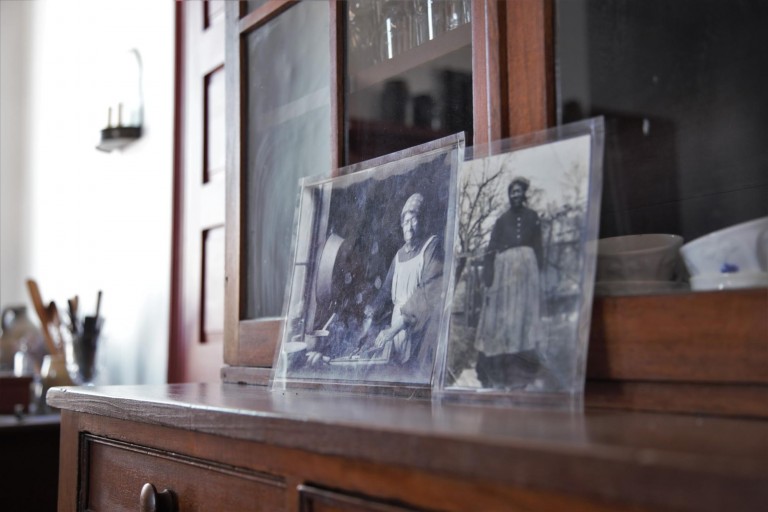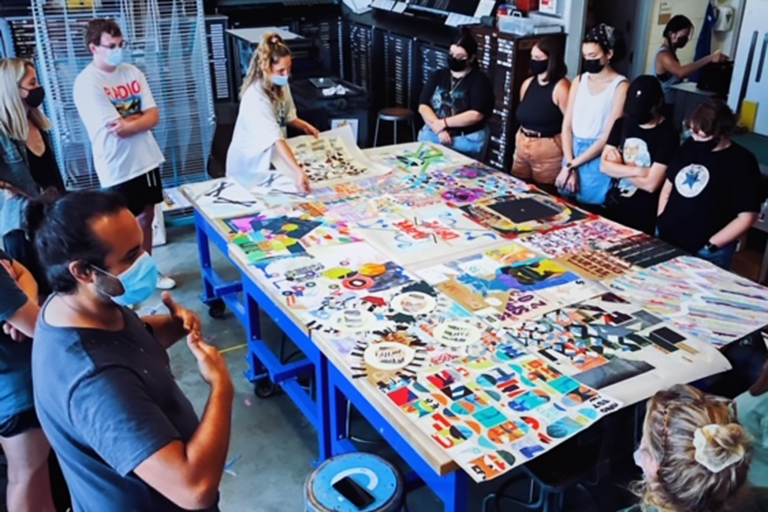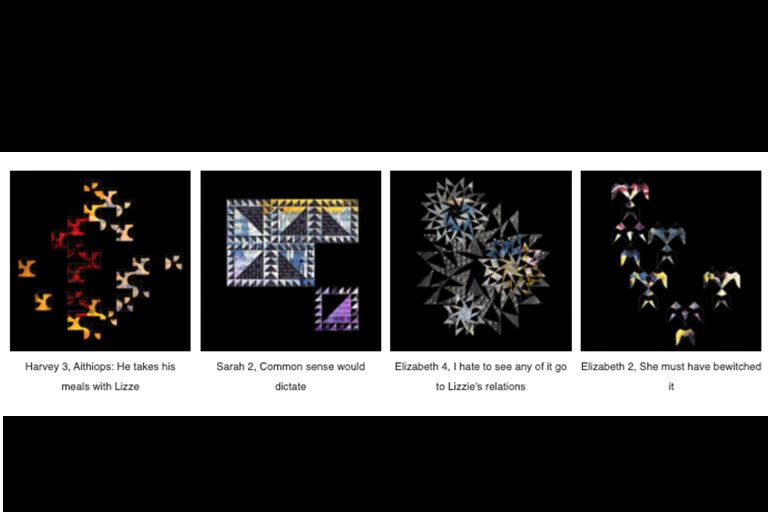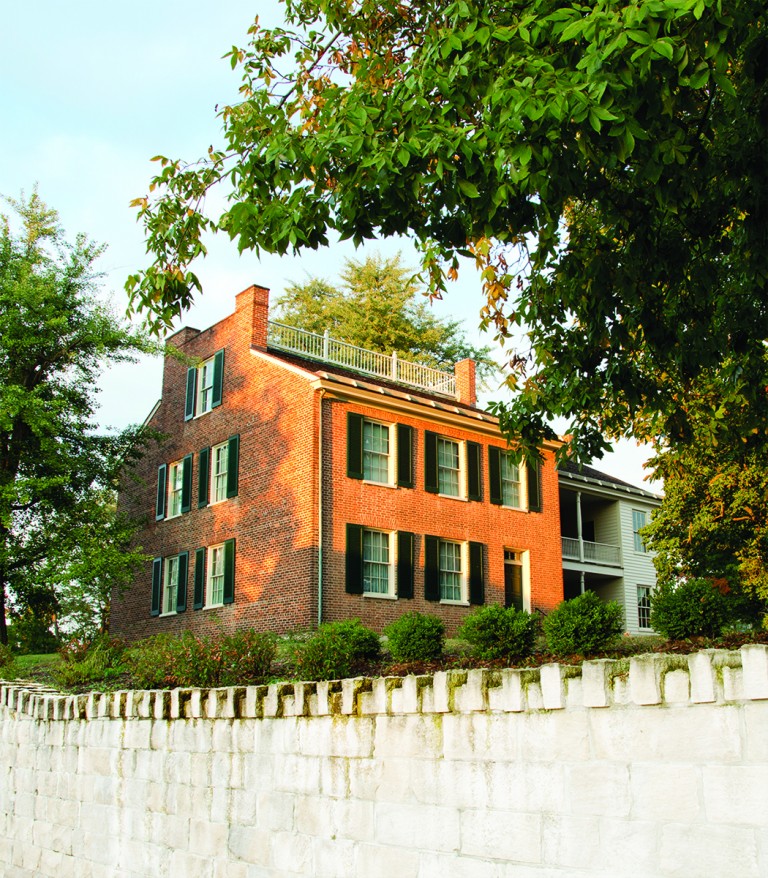Leading with intuition
Using quilt patterns from the Wylie House collections, Diacon-Furtado connects Elizabeth, Sarah, and Harvey each with a traditional quilting pattern. Elaborating on his open process of collaboration, he intuitively “goes through the documents they left, the history they left, and then the history that was written about them -- because they are different things.” While he reads through the archives on each, he observes what comes up and asks himself, “What’s piecing together? What am I reaching for?” Pointing out that one of those intuitive leaps is the connection to the quilts, he explains, “They are not really related at all, but when we start to use them and use them together, the patterns in the quilts start to explain something we were feeling about the history of Harvey, Sarah, and Elizabeth. So that’s what I’m talking about when I say I’m collaborating with them.”
Interestingly, the quilting patterns he intuitively chose are all in an accurate date range to the life of the subject. To Natan Diacon-Furtado this intuitive process does not feel like a singular act of research. “It’s not how it feels. It really is a collaboration with them as I go through their archive, and that puts the onus on me to not make something that feels false for the sake of something that looks nice.”
Choosing Wylie House Museum
For some time, Diacon-Furtado has wanted to conduct collaborative research within an archive and use history as the interactive space and raw material for his art. The Repository Research Fellowship, which is designed to highlight the collections of IU, welcomes researchers from outside the university to spend two weeks of intensive study in a unit such as the University Archives or the IU Museum of Archaeology and Anthropology. The fellowship “connected with something I’ve been trying to do,” Diacon-Furtado explains, “which is that I’ve been using patterns as a way of creating visual languages collaboratively with people for awhile now, and I’ve been really interested in tying it back to my training as a cultural anthropologist.”
Thrilled to have a spotlight on the Wylie House archives, Director Carey Champion reveals, “Natan is both the first fellow to research the museum’s collections and the first artist to earn the award. It’s exciting to see how he is using academic research to inform his works of art.” Having spotlighted marginalized occupants of the Wylie House Museum by facilitating the exhibit Call and Response, Champion engaged immediately with Diacon-Furtado over his research and art. When she showed him the Call and Response exhibit on line, he knew with certainty he had found the right place for his work.

“It’s beautiful to see a space engaging with history in that way,” Diacon-Furtado states. “Trying to build on what we know with art.” He continues, “You’re allowed to take some chances and make some leaps without objectively having to say, ‘This is the truth.’” Pointing out that we all explore histories and consider possibilities, Diacon-Furtado enthusiastically encourages those ideas in his audience. He is going for an emotional response. “Art can convey rich meaning, nuanced understandings, and complex stories,” Champion reminds us. “It can capture the essence of things and inspire emotional responses and understandings. This is incredibly useful when primary materials are unavailable or sparse, limiting the narrative capabilities.”
Both Champion and Diacon-Furtado note that the digitization of the archives made this project possible. “This would have been a much harder project to do if the Wylie House archives weren’t as easily and amazingly available online as they are,” Diacon-Furtado explained. To have a resource like the virtual walk-through truly helped him. “I couldn’t have done this project without that,” he added, “because I can actually understand the space as opposed to just seeing the documents.”
Spending Time
Having lived in the house for almost 80 years, the Wylie family left hundreds of letters, diaries, and other written materials along with physical objects. The exhibit Our Patterns, the Orator, the Astronomer, and the Poet uses pattern-making from quilts assigned to each of the three collaborators. Having been inspired by quilts his whole career, Diacon-Furtado states, “They use basic geometry to tell a story or to make something functional, and usually they do both.” Unlike the diaries and letters, the quilts were added to the Wylie House Museum later. He loves that his art is tying the quilts back into the history of the home.
The patterns are a jumping-off point for four other, open-ended patterns. Unlike quilt patterns, however, these patterns have negative spaces and undefined edges. Though viewers won’t be interacting physically, Diacon-Furtado hopes the viewer interacts emotionally and spiritually with the negative space to allow the presence of Elizabeth, Harvey, and Sarah in. “I hope it inspires curiosity, conversations, and understandings about the complexity of their lived experiences,” Champion shares. Summarizing his piece, Diacon-Furtado says, “The whole point of the project is getting to spend time with these three people who didn’t get enough time spent with them in history up to now.”
Details
The online exhibition Our Patterns, the Orator, the Astronomer, and the Poet can be found here. Diacon-Furtado’s projections from the exhibit may be seen some nights as you drive by the house. Wylie House Museum is currently open by appointment only. If you have questions, please contact Carey Champion, Director, with questions about Wylie House Museum or this exhibition at crchamp @ iu .edu or 812-856-2353.




